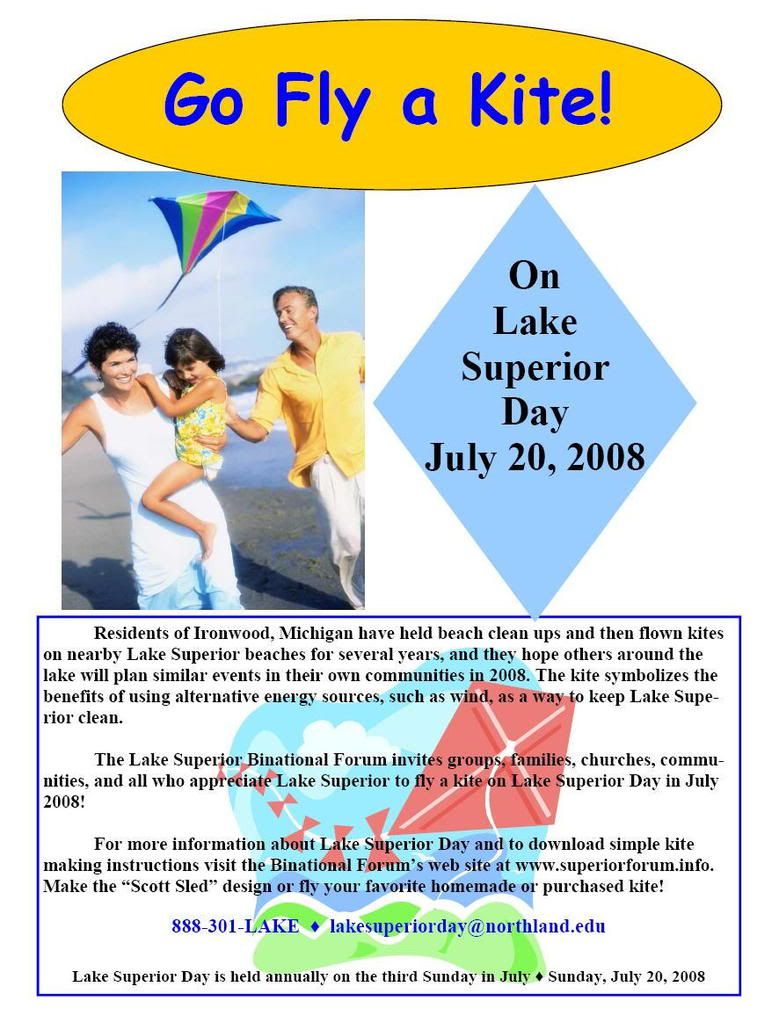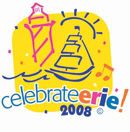

Celebrate Lake Superior Day on Sunday, July 20, 2008
Whats better than a July picnic on a hot, sandy beach next to the worlds largest freshwater lake?
A picnic and a Lake Superior celebration!
Individuals and families, churches and kids, communities and clubs, and businesses and industries hold activities or events that celebrate Lake Superior Day, held annually on the third Sunday in July (July 20 this year).
Can you do something that symbolizes your own connection to the lake on that day?

Lake Superior Day was started in the early 1990s to highlight the importance of this great water body to the basins environment and economy.
The Lake Superior Binational Forum promotes this basin-wide event to highlight the special connections people have to this unique world treasure.
Many events have been held to educate or entertain people about lake issues, special places, and recreational opportunities.

You are invited to hold activities or events that celebrate this world-class lake.
This year the theme is Lets Go Fly a Kite! to symbolize clean energy sources such as wind power.
Organize your group or family to fly a kite at your favorite beach or park on July 20!


Click on this link for more information about flying a kite on Lake Superior Day.

Families fly kites made from homemade materials off the deck of the Great Lakes Aquarium in Duluth.
Photo (above) from Minnesota Sea Grant Dec. 2007 newsletter: Making a Great Lake Superior by Sharon Moen.
Photo by Marie Zhuikov
---
Last year almost 45 groups and communities participated in some way, including special events such as dragon boat races, beach clean ups, musical concerts, library displays, church services, and signed proclamations that designate the third Sunday in July as Lake Superior Day.
Contact the Lake Superior Binational Forum to receive free color postcards and buttons to give to your Lake Superior supporters at your event.

The Forum's website offers ideas about how the day was celebrated last year and what you can do to celebrate Lake Superior. Click on Current Projects. New information is posted regularly.
For more information email organizers - or call (715) 682-1489


University of Minnesota Sea Grant Foundation photo

South Carolina Map - Geology.com
Lake Superior's surface covers 31,700 square miles, or about the size of South Carolina.
---
The lake is so big it could hold all the water from the other four Great Lakes, plus three more lakes the size of Lake Erie.

The Johnson-Sea-Link deep-sea scientific research submersible
Photo courtesy the Public Library of Science journal via Wikipedia
---
In 1985, scientists using a submersible vessel descended for the first time to the deepest part, which is near the Pictured Rocks National Lakeshore in Michigans Upper Peninsula.

Lake Superior s deepest point is 1,332 feet, which would almost cover the Sears Tower in Chicago, one of the worlds tallest buildings.
Sears Tower photo by Western Michigan University student Meghan Hurley of Glenview, Illinois.
---
The lake stretches approximately 350 miles from west to east, and 160 miles north to south. If you could travel along the entire Lake Superior shoreline, you would travel 1,826 miles, or the distance from Duluth to San Francisco.
The Lake Superior Binational Forum is a multi-sector stakeholder group of U.S. and Canadian volunteers that work together to provide input to governments about lake issues and educate basin residents about ways to protect and restore the lake.
Members come from Michigan, Minnesota, Wisconsin, and Ontario.


Northland College Ashland, Wisconsin photos courtesy:
Northland College, Liturgical Environments, Wayne Nasi Construction
---
The Forum is located in the United States at Northland College in Ashland, WI, and funded in the U.S. by a grant from the U.S. Environmental Protection Agencys Great Lakes National Program Office.


The Canadian Forum office is at EcoSuperior in Thunder Bay, Ontario, and funded by Environment Canada.


-------
Top Ten Ways You Can Protect Lake Superior Every Day

Wisconsin DNR Map
1. Install water saving devices on your kitchen and bathroom faucets and showerheads. Purchase these at local hardware and building supply stores--most cost between one dollar and nine dollars.
2. Replace regular light bulbs with energy efficient bulbs. Burning an energy bulb requires less energy, which means power plants burn less coal and that produces less mercury in the air.
3. Never burn garbage, especially plastics or tires, in burn barrels on your property. These produce more toxins in the air than an industrial incinerator. Not only do you breathe these toxic fumes as the garbage burns, but the pollutants enter the lake when it rains.
4. Instead of burning garbage, recycle or compost what you can and throw away the rest.
5. Take your lawn and household hazardous materials to area Cleansweeps collection days in Ashland, Bayfield, Douglas, and Iron counties this summer. Call the Northwest Regional Planning Commission at 715-635-2197 for dates and locations of collections in your county.
6. Put your lawn on a chemical-free diet. Poisonous lawn herbicides and pesticides seep into waterways that end up in the lake and soil, which can hurt your family and neighbors. Lawn chemicals can also sicken or kill birds and pets. Bring these kinds of chemicals to a Cleansweep event where they are disposed of safely.
7. Never pour any liquids into a storm drain. Storm drains empty untreated liquids into a nearby river, stream, or Lake Superior.
8. When youre boating or fishing, inspect your boat and trailer and remove any plants and animals before leaving the water body. Drain water from the motor, live well, bilge, and transom before leaving the water body. Never release live bait fish in the water or live earthworms on the land or water.
9. When planning landscaping or gardening activities, use plants that are native to the region. Consult with garden centers or the Sigurd Olson Environmental Institute for a list of the best native plants for this area. Learn what non-native species look like and additional prevention tips by contacting your local state or federal natural resource management agency and ask for information and identification material for non-native species.
10. Love it! When you care about something as grand as Lake Superior, youll feel good about making sure it stays a Great Lake.

For more info contact:
Lissa Radke
US Coordinator
Lake Superior Binational Forum
Sigurd Olson Environmental Institute at Northland College
Ashland, WI
54806
715-682-1489
FAX 715-682-1218
"Water is life, and the quality of water determines the quality of life." --Lake Superior Binational Forum vision statement
Lake Superior Day is celebrated on the third Sunday in July!
---

Interfaith projects to protect Lake Superior are discussed in this video by:
Rev. Tesshin Paul Lehmberg
Head Priest
Lake Superior Zendo
Zen Buddhist Temple
Rev. Jon Magnuson, LSBF board member
Lutheran Campus Ministry
Northern Michigan University
Marquette, Michigan
---
Supers:
South Carolina map courtesy Geology.com
The Johnson-Sea-Link deep-sea scientific research submersible
Photo courtesy the Public Library of Science journal via Wikipedia
Sears Tower photo by WMU student Meghan Hurley
Minnesota Sea Grant photo by Marie Zhuikov
Families fly kites made from homemade materials off the deck of the Great Lakes Aquarium in Duluth
---
For more info contact:
Lissa Radke
US Coordinator
Lake Superior Binational Forum
Sigurd Olson Environmental Institute at Northland College
Ashland, WI
54806
715-682-1489
FAX 715-682-1218
Lake Superior Binational Forum
http://www.superiorforum.info
Lake Superior Binational Forum vision statement:
"Water is life, and the quality of water determines the quality of life."
Lake Superior Day is celebrated on the third Sunday in July
---
Related websites:
---
Lake Superior Binational Forum
http://www.superiorforum.info
Flying a kite on Lake Superior Day pdf:
http://www.superiorforum.info/uploads/Kite_Poster.pdf
---
Wisconsin DNR page on Lake Superior:
http://www.dnr.state.wi.us/org/caer/ce/eek/nature/habitat/lakesuperior.htm
---
University of Minnesota Sea Grant Foundation
http://www.seagrant.umn.edu/
Minnesota Sea Grant Dec. 2007 newsletter: Making a Great Lake Superior by Sharon Moen
http://www.seagrant.umn.edu/newsletter/2007/12/making_a_great_lake_superior.html
Minnesota Sea Grant kite flying photo by Marie Zhuikov
Families fly kites made from homemade materials off the deck of the Great Lakes Aquarium in Duluth.
---
Northland College Ashland, Wisconsin photos courtesy:
Northland College:
http://www.northland.edu/Northland
Liturgical Environments:
http://www.liturgicalenvironments.com
http://www.liturgicalenvironments.com/Images/Leaded%20Glass%20Contemporary/LdNORTHLAND-COLLEGE.jpg
Wayne Nasi Construction:
http://www.wnasi.com
http://www.wnasi.com/images/portfolio/school_northland.jpg
---
EcoSuperior Environmental Programs:
http://www.ecosuperior.com
---
Environment Canada:
http://www.ec.gc.ca/
Telephone
1-819-997-2800
Canada only:
1-800-668-6767
---
Johnson-Sea-Link - Wikipedia
http://en.wikipedia.org/wiki/Johnson_Sea_Link
Harbor Branch Oceanographic Institution:
Submersible & crew info:
http://www.hboi.edu/marineops/jsl_crew.html
The Johnsen Lab page of Johnson-Sea-Link
http://www.biology.duke.edu/johnsenlab/gallery/insidechamber.html
Johnson-Sea-Link, deep-sea scientific research submersible built by The Harbor Branch Oceanographic Institution in 1971.
Submersible was designed by Edwin Albert Link, friend of Harbor Branch founder Seward Johnson.
Image first published March 15, 2005 in the Public Library of Science journal.
Source: Gulf of Mexico Cruise SJ0107
The Public Library of Science journal website states that the content of all PLoS journals is published under the Creative Commons Attribution 2.5 license.
---
South Carolina Map - Geology.com
http://geology.com/state-map/maps/south-carolina-state-map.gif
---
Sears Tower photo by Western Michigan University student Meghan Hurley of Glenview, Illinois:
http://homepages.wmich.edu/~m4hurley/searstower2_skyscraper_1.jpg
http://homepages.wmich.edu/~m4hurley














































